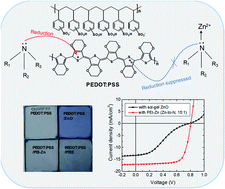A metal chelation strategy suppressing chemical reduction between PEDOT and polyethylenimine for a printable low-work function electrode in organic solar cells†
Abstract
Poly(3,4-ethylenedioxythiophene):poly(styrene sulfonate) (PEDOT:PSS) with high electrical conductivity and optical transmittance is regarded as a promising printable transparent electrode for organic solar cells. Intrinsically, it has a high work function because PEDOT is in an oxidized state. The oxidized state is prone to chemical reduction by polyethylenimine (PEI) or ethoxylated PEI (PEIE) or sol–gel ZnO precursors (ethanolamine contained) during work function tuning. In this work, we report zinc-ion chelated PEIE (denoted as PEI-Zn) deposited on the PEDOT:PSS electrode to reduce its work function as an efficient electron-collecting electrode. The introduction of zinc ions can effectively suppress the chemical reduction of PEDOT:PSS films by PEIE. High optical transmittance and electrical conductivity of PEDOT:PSS remain during the coating. The PEI-Zn can be as thick as 70 nm on PEDOT:PSS as an interlayer. Devices were fabricated on the low-work function PEDOT:PSS/PEI-Zn electrode. With the active layer of PM6:Y6, the cell shows a power conversion efficiency of 11.2% (open-circuit voltage of 0.81 V, short-circuit current of 21.3 mA cm−2, and fill factor of 0.65).



 Please wait while we load your content...
Please wait while we load your content...